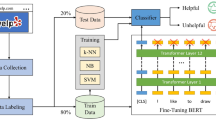Abstract
The problem of personalized review-based rating prediction aims at inferring users’ ratings over their unrated items using historical ratings and reviews. Most of existing methods solve this problem by integrating latent factor model and topic model to learn interpretable user and items factors. However, these methods ignore the word order in reviews and the learned topic factors are limited to review text, which cannot fully reveal the complicated interaction relations between reviews and ratings. Moreover, they only utilize overall ratings instead of multi-criteria ratings which can represent more detailed preferences of users. In this paper, we propose a deep learning framework named NRPMT in which multi-criteria ratings and user reviews can complement each other to improve recommendation accuracy. The proposed model can simultaneously predict accurate ratings and generate review content expressing user experience and feelings. For rating prediction, a neural factorization machines-based regression model are used to project the feature interactions between user, item and criteria into rating. For review generation, gated recurrent neural networks are employed to “translate” the feature representation of user, item and criteria into a review. Extensive experiments on three real-world datasets demonstrate that NRPMT achieves significant improvement over the several competitive baselines.



Similar content being viewed by others
References
Bell, R.M., Koren, Y.: Lessons from the Netflix prize challenge. KDD Explor. 9(2), 75–79 (2007)
Koren, Y., Bell, R.M., Volinsky, C.: Matrix factorization techniques for recom mender systems. IEEE Comput. 42(8), 30–37 (2009)
Chen, L., Chen, G.L., Wang, F.: Recommender systems based on user reviews: the state of the art. User Model. User-Adapt. Interact. 25(2), 99–154 (2015)
McAuley, J., Leskovec, J.: Hidden factors and hidden topics: understanding rating dimensions with review text. In: Proceedings of the 7th ACM Conference on Recommender Systems, pp. 165–172. ACM (2013)
Ling, G.M., Lyu, R., King, I.: Ratings meet reviews, a combined approach to recommend. In: Proceedings of the 8th ACM Conference on Recommender systems, pp. 105–112. ACM (2014)
Diao, Q., Qiu, M., Wu, C.Y., et al.: Jointly modeling aspects, ratings and sentiments for movie recommendation (JMARS). In: ACM Sigkdd International Conference on Knowledge Discovery & Data Mining, pp. 193–202 (2014)
Johnson, R., Zhang, T.: Effective use of word order for text categorization with convo lutional neural networks. In: The 2015 Conference of the North American Chapter of the Association for Computational Linguistics: Human Language Technologies, pp. 103–112 (2015)
Fuchs, M., Zanker, M.: Multi-criteria ratings for recommender systems: an empirical analysis in the tourism domain. In: International Conference on Electronic Commerce and Web Technologies, pp. 100–111. Springer Berlin Heidelberg (2012)
Jhalani, T., Kant, V, Dwivedi P.: A linear regression approach to multi-criteria recommender system. In: The Second International Conference on Data Mining and Big Data, pp. 35–243. Springer, New York (2016)
Sahoo, N., Krishnan, R., Duncan, G., et al.: Research note-the halo effect in multi component ratings and its implications for recommender systems: the case of yahoo! movies. Inf. Syst. Res. 23(1), 231–246 (2012)
Hochreiter, S., Schmidhuber, J.: Long short-term memory. Neural Comput. 9(8), 1735–1780 (1997)
Bahdanau, D., Cho, K., Bengio, Y.: Neural machine translation by jointly learning to align and translate. In: Proceedings of the 3rd International Conference on Learning Representations (2015). arXiv:1409.0473
He, X.N., Liao L.Z., Zhang, H.W., et al.: Neural collaborative filtering. In: Proceedings of the 26th International Conference on World Wide Web, pp. 173–182 (2017)
Wang, H., Wang, N.Y., Yeung, D.Y.: Collaborative deep learning for recommender systems. In: Proceedings of the 21th ACM SIGKDD International Conference on Knowledge Discovery and Data Mining, pp. 1235–1244 (2015). ACM
He, X.N., Chua, T.S.: Neural factorization machines for sparse predictive analyt ics. In: Proceedings of the 40th International ACM SIGIR Conference on Research and Development in Information Retrieval, pp. 355–364 (2017). ACM
Wang, Y., Liu, Y., Yu, X.: Collaborative filtering with aspect-based opinion mining: a tensor factorization approach. In: IEEE Proceedings of the 12th IEEE International Conference on Data Mining, pp. 1152–1157 (2012)
Rendle, S.: Factorization machines with libFM. ACM Trans. Intell. Syst. Technol. 3(3), 1–22 (2012)
Juan, Y., Zhuang, Y., Chin, W.S., et al.: Field-aware factorization machines for CTR prediction. In: ACM Conference on Recommender Systems, pp. 43–50 (2016). ACM
Hong, L.J., Doumith, A.S., Davison, D.D.: Co-factorization machines: modeling user interests and predicting individual decisions in Twitter. In: Proceedings of the 6th ACM International Conference on Web Search and Data Mining, pp. 557–566 (2013). ACM
Almahairi, A., Kastner, K., Cho, K., Courville, A.: Learning distributed representations from reviews for collaborative filtering. In: Proceedings of the 9th ACM Conference on Recommender Systems, pp. 147–154 (2015). ACM
Kim, D.Y., Park, C.Y., Oh, J., et al.: Convolutional matrix factorization for docu ment context-aware recommendation. In: Proceedings of the 10th ACM Conference on Recommender Systems, pp. 223–240 (2016). ACM
Jin, Z., Li, Q., Zeng, D.D., et al.: Jointly modeling review content and aspect rat ings for re view rating prediction. In: International ACM SIGIR Conference on Research and Development in Information Retrieval, pp. 893–896 (2016). ACM
Rumelhart, D.E., Hinton, G.E., Williams, R.J.: Learning representations by back propagating errors. Nature 323(6088), 533–536 (1986)
Kiros, R., Zhu, Y.K., Salakhutdinov, R., et al.: Skip-thought vectors. In: Advances in Neural Information Processing Systems 28 (NIPS): Annual Conference on Neural Information Processing Systems, pp. 3294–3302 (2015)
Acknowledgements
This work was financially supported by the National Natural Science Foundation of China (Grant: 61502350) and Joint Funds of National Natural Science foundation of China (Grant: U1536114).
Author information
Authors and Affiliations
Corresponding author
Rights and permissions
About this article
Cite this article
Ding, Y., Li, S., Yu, W. et al. A unified neural model for review-based rating prediction by leveraging multi-criteria ratings and review text. Cluster Comput 22 (Suppl 4), 9177–9185 (2019). https://doi.org/10.1007/s10586-018-2098-y
Received:
Revised:
Accepted:
Published:
Issue Date:
DOI: https://doi.org/10.1007/s10586-018-2098-y




